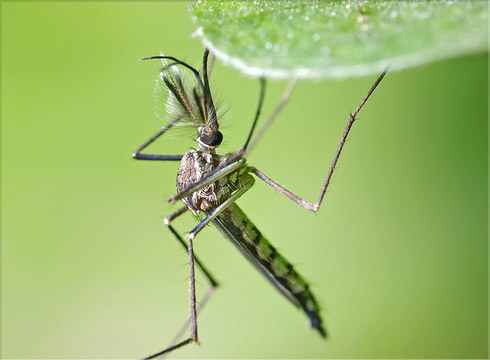
About The Pest
Mosquitoes are not only annoying, they also create real risks. The itchy red bumps after a bite frustrate many people, but the danger goes beyond discomfort. Mosquito-borne diseases like malaria and yellow fever have caused major outbreaks across the world. While most U.S. residents don't face the same high risk, local mosquito species can still spread illnesses like West Nile virus and eastern equine encephalitis.
Mosquito Identification & Facts
Mosquitoes are insects from the family Culicidae, which also includes gnats, crane flies, and midges. They are found throughout the U.S. and are mainly active in summer and autumn, especially from June to October. They range in size from 1/4 to 3/8 of an inch. Identifying mosquito species is sometimes hard because mosquitoes are small and skilled evaders. However, each one has its preferred habitat and feeding behavior.
All mosquitoes have long legs and slender bodies. But not all of them feed on humans or behave the same way. Some breed in freshwater, while others prefer saltwater. Some like to feed on birds, and others prefer humans. Female mosquitoes have a long, pointed mouthpart called a proboscis for blood feeding. Males do not bite and are usually smaller, with bushier antennae.
Mosquitoes are one of the most common warm-weather pests in New England. New Hampshire alone has recorded over 43 species. These insects have keen senses and find hosts by sensing body heat and carbon dioxide in the air.
Only female mosquitoes bite, using blood to grow their eggs, while the smaller males survive on plant nectar. These insects lay eggs in stagnant water in places like marshes, clogged gutters, old tires, and even small puddles. In the U.S., mosquitoes can spread diseases such as West Nile virus, dengue fever, and encephalitis. In rare cases, they can transmit malaria. Symptoms range from mild, self-limiting illnesses to serious conditions. If you feel unwell after a bite, consult a medical professional immediately.
Seasonality
In New England, mosquito season usually starts in June and lasts until October. These months have warm temperatures and regular rainfall, which help mosquitoes breed. The life cycle of a mosquito, from egg to adult, takes about a week. This is why there are so many mosquitoes. By late summer, their populations peak, leading to more bites and higher disease risks. Which is why acting early when you see the signs of mosquitoes in your yard, using a professional mosquito control service can protect your home and family.
Homeowners often use mosquito-repellent plants and herbs like lavender, mint, and basil, as well as essential oils. However, this doesn’t stop mosquitoes from breeding. To control infestations, it’s important to eliminate standing water.
When Are Mosquitoes Most Active?
Most mosquitoes are crepuscular, meaning they are most active during the early morning, late evening, and at dusk. During these times, the air is cooler and the sun is lower, giving mosquitoes the best chance to find a host. However, some species will also feed during the day, especially in shaded, wooded, or damp areas. Being aware of these active periods can help you plan outdoor events better or take precautions that could reduce your risk of getting bitten.
One of the best ways to protect yourself from mosquito bites during these times (and the diseases they carry) is by understanding what attracts them to you. Factors like what you wear, how you smell, what you eat, and even how much you breathe can all send signals that mosquitoes interpret as “dinner time.” To learn more about these surprising mosquito attractants, check out our blog on weird things that attract mosquitoes.
Recognizing Mosquitoes vs. Similar Insects
Mosquitoes are often confused with other small flying insects like midges and crane flies. To improve your mosquito identification skills, look for the prominent physical features. Mosquitoes have long, narrow bodies, a distinct proboscis, and scaled wings. Conversely, crane flies are larger, with long legs and no biting mouthparts. On the other hand, midges are smaller and often swarm, but they don’t bite. If an insect bites and leaves an itchy bump, it's likely to be a mosquito.
Frequently Asked Questions
What Do Mosquitoes Look Like?
Mosquitoes are small, slender insects with long legs and a narrow body. They have one pair of wings and a proboscis used for feeding. Mosquito identification is difficult: their color can range from gray to dark brown, often with white stripes on the legs or body.
When Are Mosquitoes Most Active During the Day?
Most mosquitoes are active during early morning, late afternoon, and evening, though some species may bite in shady or humid areas during the day. These peak times make it important to take precautions if you're spending time outdoors.
Why Do Mosquitoes Bite?
Only female mosquitoes bite because they need the protein in blood to produce eggs. Males do not bite and feed on plant nectar. Female bites are often itchy due to a mild allergic reaction to their saliva.
Are Male and Female Mosquitoes Different in Behavior or Appearance?
Female mosquitoes are larger, have a blood-feeding proboscis, and are responsible for biting. Males are smaller and only feed on nectar. You can often tell them apart by looking at the antennae—males have bushier ones.
